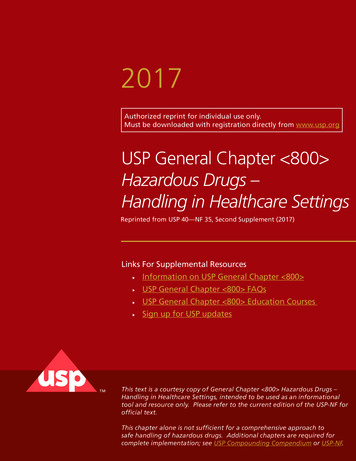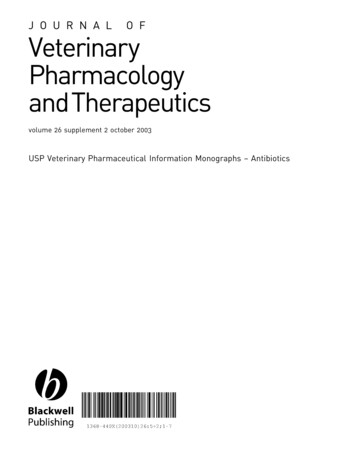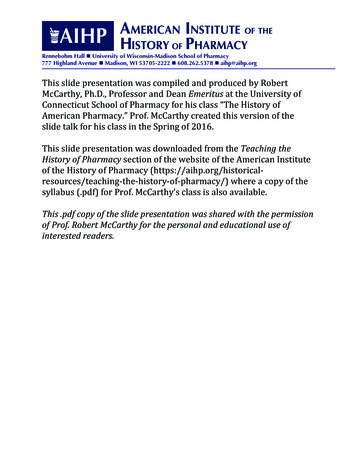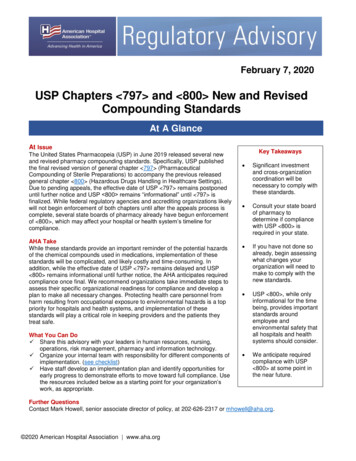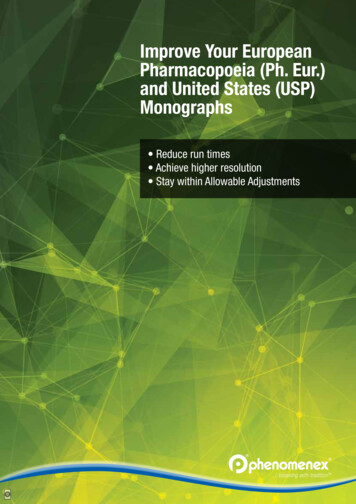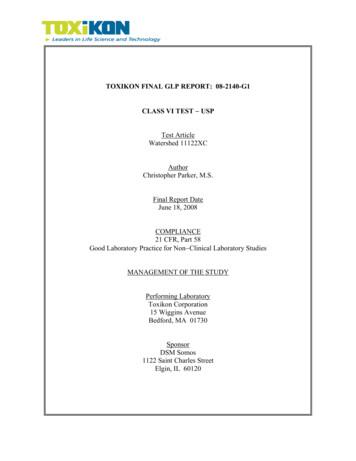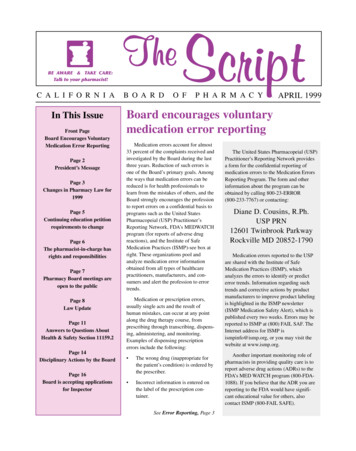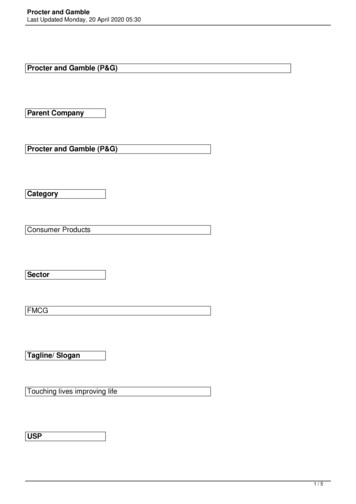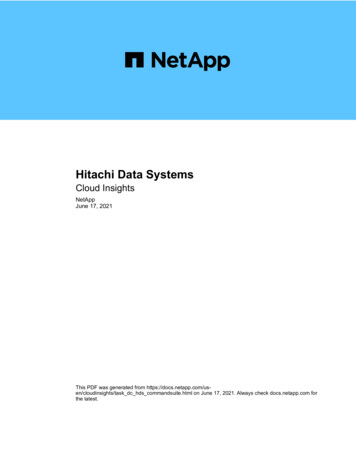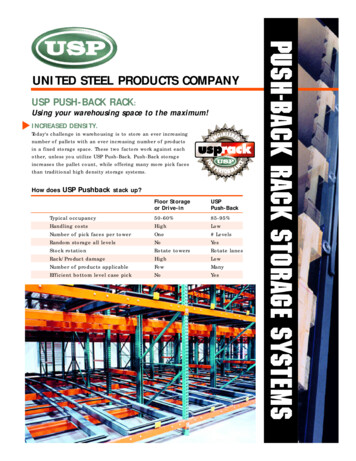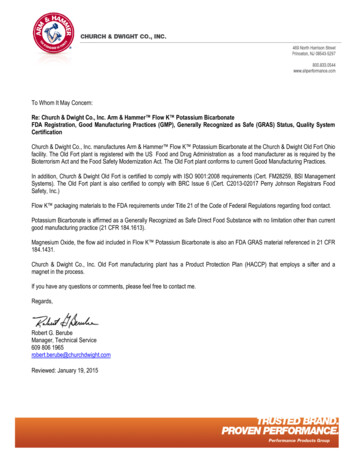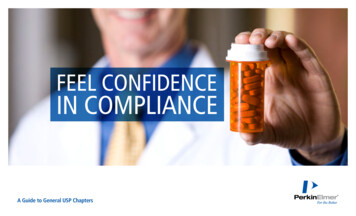
Transcription
FEEL CONFIDENCEIN COMPLIANCEA Guide to General USP Chapters
Understanding USP ChaptersIntroductionQuality and consistency of medicines is crucial to ensure their identity, strength, and purity is at a safe level for human consumption.That’s why we rely on strict guidelines – to guarantee medications that make it to the shelves are exactly what they claim to be.USP 467 Residual SolventsUSP 232 and 233 Elemental ImpuritiesHere’s a simple breakdown of USP chapters and what they contain: General USP chapters below 1000 provide guidelineson activities related to the tests and procedures in pharmacopeial articles. They may contain descriptions of tests and procedures,information on the interpretation of compendial requirements, and general guidance on official substances or official products.General chapters above 1000 don’t contain any standards, tests, assays, or mandatory specifications. Instead, these excerptsinclude pertinent Federal Acts and regulations.The official requirements for Pharmacopeia can be found in the general notices, individual monographs, and general tests and assayschapters. Monographs contain tests, procedures, and criteria to ensure the identity, strength, quality, and purity of an article. Amonograph also contains the article’s name, definition, specification, and other requirements related to packaging, storage, and labeling.See below for a 200-year timeline of USP history to understand how it’s evolved into the monographs and reference standardswe follow today.1820193819752020The first United StatesPharmacopeia (USP)was published.The Federal Food, Drug, and Cosmetic Actexpands the roles for applicable USP andNational Formulary (NF) standards to includenonproprietary naming and misbranding.USP purchased the NF, combiningthe two publications underone cover to create the UnitedStates Pharmacopeia–NationalFormulary (USP–NF).200 years ofbuilding trustUSP 671 Containers Performance TestingUSP 711 Dissolution TestingUSP 1663 and 1664 Extractables and LeachablesUSP 857 UV-VisUSP 1058 Analytical Instrument QualificationSelection Guide:Chromatographic ColumnsService and SupportContact Us
IntroductionUSP 232 and 233 Elemental ImpuritiesUSP 232 and 233 Elemental ImpuritiesUSP 467 Residual SolventsUSP 671 Containers Performance TestingUSP 711 Dissolution TestingPushing the Limits of ImpuritiesWant to know more? Explore our links. 232 Elemental Impurities – RestrictionsThis chapter plays an important role in drug development. It specifieslimits for elemental impurities in all medications. Because acceptablelevels depend on the material’s use, manufacturers need certaininformation about the content of elemental impurities in drugsubstances or excipients in order to meet the criteria. 233 Elemental Impurities – ProceduresThis chapter describes two analytical procedures for the evaluation ofelemental impurity levels in medications. It also describes criteria foracceptable alternative procedures. Alternative procedures that meetthe validation requirements may be used in accordance with GeneralNotices: 6.30 Alternative and Harmonized Methods and Procedures.Our Technology Solutions:ICP-MSICP-OESRead our brochure to learn more about exposure limits for elementalimpurities in pharmaceutical products.Read our application note to learn about testing and validating variousantacids for elemental impurities using our NexION 2000 ICP-MS.Read our application note to learn about analyzing SiO2 and TiO2 inmedications using ICP-OES.Read our application note to learn about using ICP-OES to analyzeallergy medications.Read our application note to learn about the determination of traceelements in eye drops using the NexION ICP-MS.Microwave Sample PreparationUSP 1663 and 1664 Extractables and LeachablesUSP 857 UV-VisUSP 1058 Analytical Instrument QualificationSelection Guide:Chromatographic ColumnsService and SupportContact Us
IntroductionUSP 232 and 233 Elemental ImpuritiesUSP 467 Residual SolventsUSP 467 Residual SolventsUSP 671 Containers Performance TestingUSP 711 Dissolution TestingUSP 1663 and 1664 Extractables and LeachablesKeeping Residual Solvents Under ControlResidual solvents are organic volatile chemicals that are used orproduced in the making of drug substances, excipients, or dietaryingredients. This chapter provides procedures for analyzing residualsolvents. In addition, alternative validated methodologies may be usedto demonstrate compliance with the defined limits.Further guidance on USP-verified procedures – or validation ofalternative methods for residual solvents – can be found under 1467 Residual Solvents—Verification of Compendial Proceduresand Validation of Alternative Procedures.Our Technology SolutionsGas ChromatographyAutomated Headspace SamplerWant to know more? Explore our links.USP 857 UV-VisRead our application note to learn about residual solvents inpharmaceuticals by USP methodology.USP 1058 Analytical Instrument QualificationRead our application note to learn about pressure-balancedheadspace for residual solvents in pharmaceuticals byUSP methodology.Selection Guide:Chromatographic ColumnsService and SupportContact Us
IntroductionUSP 232 and 233 Elemental ImpuritiesUSP 467 Residual SolventsUSP 671 Containers Performance TestingUSP 671 Performance Testing ContainersUSP 711 Dissolution TestingUSP 1663 and 1664 Extractables and LeachablesUSP 857 UV-VisEnsuring the Quality of Primary PackagingWhen it comes to determining the primary packaging quality ofdrug products, plastic material is analyzed and accepted based on itsidentity, biocompatibility, general physiochemical properties,and composition.Want to know more?USP 1058 Analytical Instrument QualificationFor more about the spectral transmission ofpharmaceutical containers in accordance with USP 671 ,read our application note.Selection Guide:Chromatographic ColumnsService and SupportThis chapter provides standards for drug packaging used for solidoral dosage forms (SODFs) and liquid oral dosage forms (LODFs).It also includes a classification system that allows pharmacistsand institutional repackagers to select appropriate containers torepackage these SODFs and LODFs.Our Technology Solutions:DSCTGAFT-IRContact UsFT-IR Imaging Systems
IntroductionUSP 232 and 233 Elemental ImpuritiesUSP 711 Dissolution TestingUSP 467 Residual SolventsUSP 671 Containers Performance TestingUSP 711 Dissolution TestingUSP 1663 and 1664 Extractables and LeachablesUSP 857 UV-VisThe Prescription for Peace of MindFor pharmaceutical labs like yours, dissolution testing is a crucial stepin the drug development process, from early product development tolate-stage quality control in commercial manufacturing.Working with the FDA and USP, we’ve helped set guidelines, includingvibration limit evaluations and settings, including mechanical calibrationand USP Performance Verification Test (PVT) services.USP, the European Pharmacopoeia (EP), and the JapanesePharmacopoeia (JP) all have different standards. These three groups areworking together to create one harmonized chapter with guidelinesthe global industry can follow.Want to know more? Explore our links.USP 1058 Analytical Instrument QualificationWatch our webinar to learn more about taking the strain out ofdissolution testing.Selection Guide:Chromatographic ColumnsExplore our brochure to learn about the right solutions fordissolution testing in your lab.Service and SupportContact UsOur Technology SolutionsUV-Vis
IntroductionUSP 232 and 233 Elemental ImpuritiesUSP 1663 and 1664 Extractables and LeachablesUSP 467 Residual SolventsUSP 671 Containers Performance TestingUSP 711 Dissolution Testing 1663 Extractables Associatedwith Pharmaceutical Packaging andDelivery Systems 1664 Drug Product LeachablesAssociated with PharmaceuticalPackaging and Delivery SystemsThis chapter provides a guideline for the design,justification, and execution of an extractables assessment forpharmaceutical packaging and delivery systems. It establishescritical dimensions of an extractables assessment and discussespractical and technical aspects of each dimension.This chapter presents a framework for the design, justification,and implementation of assessments for leachables derivedfrom pharmaceutical packaging and delivery systems. Becauseleachables can affect drug product efficacy, safety, andquality, this assessment is important to manufacturers andtheir suppliers to establish the suitability of pharmaceuticalpackaging and delivery systems.Our Technology SolutionsGC-MSUSP 857 UV-VisUSP 1058 Analytical Instrument QualificationSelection Guide:Chromatographic ColumnsService and SupportContact UsICP-MSWant to know more?USP 1663 and 1664 Extractables and LeachablesTo learn more about the assessment of extractables and leachables in pharmaceutical packaging, read our white paper.
IntroductionUSP 232 and 233 Elemental ImpuritiesUSP 467 Residual SolventsUSP 671 Containers Performance TestingUSP 857 Ultraviolet-Visible SpectroscopyUSP 711 Dissolution TestingUSP 1663 and 1664 Extractables and LeachablesCompliance, from Beginning to EndIn ultraviolet-visible (UV Vis) spectroscopy, your instrumentationneeds to be deemed suitable for analysis. This is done throughqualification tests, including: design qualification (DQ); installationqualification (IQ); an initial performance-to-specificationqualification, also known as operational qualification (OQ); and anongoing performance qualification (PQ).For example, our LAMBDA 365 meets the compliance andperformance needs of pharmaceuticals, analytic chemists,geneticists, and manufacturing QA/QC analysts everywhere.With 21 CFR Part 11 compliant software available, the LAMBDAsystem is ready to support everything from standard methods andapplications to regulatory compliance.USP 857 UV-VisWant to know more?For more information about data integrity of UV WinLabEnhanced Security (ES) software for UV Vis, read our whitepaper.USP 1058 Analytical Instrument QualificationSelection Guide:Chromatographic ColumnsService and Support Contact Us
USP 1058 Analytical Instrument QualificationIntroductionUSP 232 and 233 Elemental ImpuritiesUSP 467 Residual SolventsMaintaining Data QualityThis informational chapter provides you with scientific, risk-based approaches for carrying outanalytical instrument qualifications (AIQs). It explains various terms, acronyms, and activitiescommon to analytical laboratories and validation disciplines like yours.Want to know more?USP 671 Containers Performance TestingFor more on instrumentqualification, click here.USP 711 Dissolution TestingUSP 1663 and 1664 Extractables and LeachablesWe offer several traditional qualification protocols and services for lab instruments, ensuringcomplete, consistent, and accurate data.USP 857 UV-VisOur services provide: Qualification protocols usingcalibration standards Custom protocol development Execution of customer-developedprotocols IQ/OQ protocol libraryCOMPONENTS OF DATA QUALITYQualityControlCheck SamplesAnalysts perform tests on standardized instruments. Some analyses alsorequire the inclusion of quality control check samples to provide anin-process or ongoing assurance of the test's performance.System Suitability TestsAnalytical Method ValidationAnalytical Instrument QualificationSystem suitability tests verify that thesystem will perform properly.Analytical method validation is the collection of documentedevidence that an analytical procedure is suitable for its intended use.AIQ is the collection of documented evidence that aninstrument performs suitably for its intended purpose.Use of a qualified instrument ensures your data is sound.USP 1058 Analytical Instrument QualificationSelection Guide:Chromatographic ColumnsService and SupportContact Us
IntroductionChromatographic Columns Selection GuideUSP 232 and 233 Elemental ImpuritiesUSP 467 Residual SolventsNever Miss a PeakUSP 671 Containers Performance TestingWhatever your separation challenge, your choice of liquid chromatography (LC) column can make all the difference.Click on each type of LC column below to choose one that fits your lab’s needs.Ibuprofen chlorideOral SolutionTrihexyphenidylHydrochlorideTabletsUSP 711 Dissolution TestingTrihexyphenidylHydrochlorideUSP 857 P 1058 Analytical Instrument QualificationSelection Guide:Chromatographic ColumnsWant to know more? Read our application briefs:Service and Support Indoxyl Sulfate Ibuprofen Penicillin and Amoxicillin Naproxen Clopidogrel Atorvastatin Simvastatin Warfarin Cephalosporins Tramadol Ciprofloxacin AzithromycinFor our full range of consumables, click here and browse by technology.USP 1663 and 1664 Extractables and LeachablesContact Us
IntroductionService and SupportUSP 232 and 233 Elemental ImpuritiesUSP 467 Residual SolventsWe’re Here for You, Whenever You Need UsFrom instrument qualification and computer system validation to data integrity, our services and support ensure that your data is complete,consistent, and accurate. It’s important to meet or exceed qualification regulations, and we have everything you need to keep your science on track.INSTRUMENT QUALIFICATIONInstrument Qualification methods guide your lab through automated, secure electronic ortraditional paper qualification procedures with standard OQ protocols customized to yourspecifications. Click here to learn more.COMPUTER SYSTEM VALIDATIONUSP 671 Containers Performance TestingUSP 711 Dissolution TestingUSP 1663 and 1664 Extractables and LeachablesUSP 857 UV-VisUSP 1058 Analytical Instrument QualificationWe offer CSV support to ensure your instrument data is error free. We promote efficiencieswherever possible and offer simple approaches to enable you to meet validationrequirements. Click here to learn more.Selection Guide:Chromatographic ColumnsDATA INTEGRITYContact UsEnsuring the integrity of your data is crucial. Our OneSource solution is based on centralizedmonitoring and continual improvements that enable you to pursue science with integrity –and compliance. Click here to learn more.Service and Support
For more information on our pharmaceutical QA/QC solutions, click here.PerkinElmer, Inc.940 Winter StreetWaltham, MA 02451 USAP: (800) 762-4000 or( 1) 203-925-4602www.perkinelmer.comFor a complete listing of our global offices, visit www.perkinelmer.com/ContactUsCopyright 2020-2021, PerkinElmer, Inc. All rights reserved. PerkinElmer is a registered trademark of PerkinElmer, Inc. All other trademarks are the property of their respective owners.74880 PKI
The first United States Pharmacopeia (USP) was published. 1938 1975 2020 200 years of building trust USP purchased the NF, combining the two publications under one cover to create the United States Pharmacopeia-National Formulary (USP-NF). The Federal Food, Drug, and Cosmetic Act expands the roles for applicable USP and
